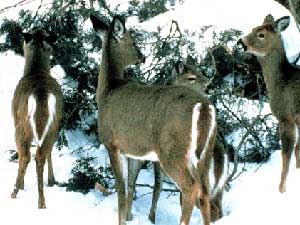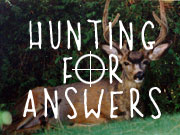Managing the deer herd
November 18, 2002
 |
| The Minnesota whitetail deer herd is estimated at one million animals, and the DNR says that high population may lead to the spread of chronic wasting disease into the state. (Photo courtesy of Wisconsin DNR) |
Worthington, Minn. — Many people can remember when seeing deer in the wild was an unexpected treat. Lynn Holmstrom of Granite Falls has lived in her home on the edge of the city 24 years.
"When we first moved in, there might be a mom with a couple of fawns, and that would be about it. Then they were fun to watch," Holmstrom says. "Now they're not."
Holmstrom says at least a dozen deer feed regularly on the plants and trees in her neighborhood.
"I hate to shoot Bambi, but on the other hand, it's just getting out of hand. They're all over, there's just too many of them."
 | |||
Hunters take about 200,000 deer a year in Minnesota. Predators and traffic accidents kill another 100,000 or more. But even though one-third of the Minnesota deer herd dies each year, wildlife managers are still worried about controlling the population. Deer can reproduce rapidly because the state offers plenty of food and shelter.
Steve Merchant of the Minnesota Department of Natural Resources says controlling deer numbers is a priority.
"That is, I think, the No. 1 challenge facing wildlife managers. And it's one that we don't take lightly," says Merchant.
There's no better place to see the impact of one million deer than on Minnesota highways. It's not unusual to see a dead deer by the side of the road. The DNR estimates 15,000 deer die in vehicle collisions each year. State crash statistics show deer cause more major accidents in Minnesota than drunk drivers.
Mary Wells Gorman lives on the west side of the Twin Cities. Twice she's been in cars that hit deer. Even thought the accidents occured more than seven years ago, she still remembers them vividly.
 | |||
"My kids screaming -- and us getting showered with glass. I see them in my mind again. It was just very frightening, very scary," Gorman says.
She's reminded of the accidents every time she sees a dead deer on the highway.
"It leaves us now a sense that there's an unforeseeable, uncontrollable force that is on the road. There's no way to brace yourself or to understand what calamity is coming upon you," she says.
Gorman is far from alone. By one estimate there are almost 20,000 deer-vehicle crashes in the state each year. Last year those accidents killed five people and injured 500. Vehicle damage was in the millions of dollars. But the DNR's Steve Merchant says the accidents are not always the deer's fault.
"People seem to drive faster and we drive more, and we tend to be in a hurry to where we're going to. So I think it's a combination of having high deer numbers, and perhaps drivers that aren't being as observant as they should be out there, and it leads to problems," says Merchant.
 | |||
The biggest trouble spot is in the area with the most cars -- the Twin Cities. Roughly one-fourth of the state's deer crashes occur there. Controlling the Twin Cities herd is difficult, because most of the area is closed to public hunting. And Merchant says public pressure against killing deer makes it difficult to hold special hunts in problem areas.
"Our view is that we should be hunting deer wherever it's safe to hunt deer. But lots of local units of governments don't see it that way," Merchant says.
The genesis of the state's huge deer herd can be traced back 30 years. In 1971, the DNR closed the deer hunting season after a series of severe winters sharply reduced numbers.
At the same time, the agency started a new deer management system. The state was divided into more than 120 units, and the kill in each unit was controlled to ensure maximum deer numbers. The state's whitetail population more than tripled in 30 years. But some say the system has worked too well -- even some hunters says there are too many deer.
"I would hope that DNR would say, we need to cut down on the deer population right now. Let's be proactive instead of waiting until after the fact," says T.R. Michels, who makes his living in the outdoors.
 | |||
From his base in southeast Minnesota, Michels guides hunters, and writes and speaks about deer. He's worried about chronic wasting disease. Although CWD has not been found in the state's deer herd, he believes it will show up in time. If that happens, Michels says the more deer there are, the easier it will be for the disease to spread.
"We don't know how CWD is transmitted, whether it's airborne, whether it's urine, it's feces, it's placenta, saliva or anything else. We simply do not know," Michels says. "What we do know is that when deer are confined in small areas, and they're sick, other deer are going to get it."
Michels says anyone feeding deer should stop. Beyond that, he says it's up to the DNR to reduce deer numbers. In fact, Michels says the agency should revamp its entire management scheme.
Michels says the DNR has done a great job of enlarging the deer herd -- but it has come at a price. Disease and traffic accidents are a couple of examples. And he says many hunters are unhappy about another effect of the current deer management system.
 | |||
"Trophy hunting in Minnesota is almost non-existent. There ain't that many good bucks around," Michels says.
DNR managers protect female deer to a greater extent than males. This maintains a large breeding herd and high deer numbers. But Michels says it also means bucks are over-hunted -- few survive more than a year or two. Michels would like to see more does killed each year, which would reduce overall deer numbers. And by killing fewer males, the ratio of trophy bucks would increase.
The DNR has not shown much interest in the idea. Surveys show hunters don't like it either. Most say they're happy with the current management scheme. The DNR's Steve Merchant says hunter opinion is important.
"They basically pay for the management of whitetail deer in Minnesota, and so they do have a strong influence on our policy," Merchant says.
The DNR has been criticized for paying too much attention to hunters. People who hit a deer on the highway might wonder if the DNR wants a million deer in the state solely to please hunters.
"We aren't beholden to deer hunting groups," says Merchant. "But we certainly do listen to them, and they're very important."
Hunters will be very important this fall. DNR officials are counting on them to take a large number of deer to keep the state's million plus white-tail population under control.
The number of people pursuing deer in recent years has increased, but at a slower rate than in the past. That's a cause for concern, during a time when game managers are more anxious than ever about the number of deer in the state.
|
News Headlines
|
Related Subjects
|

